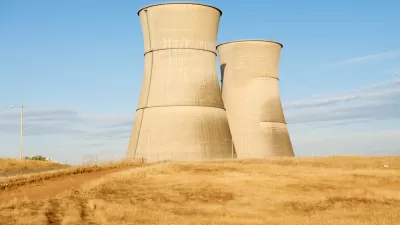The Hanford Nuclear Reservation is called the nation's most contaminated place, with pits containing nuclear waste like plutonium. It's also a historic site in terms of America's dabblings with nuclear weaponry, and now it's open for tours.
The federal government is easing security restrictions and allowing thousands of people to visit the site this year. It's part of a move to create more understanding about nuclear power, but also about the severe challenges of storing its waste and cleaning up its messes.
"The U.S. Department of Energy is making Hanford more accessible to the public this year than at any time in the area's notoriously secret history. More than 2,500 people booked tickets for a free, five-hour tour (60 in all) within 24 hours after the DOE made reservations available online. Another 1,000 people will likely visit the historic B Reactor - the heart of the Manhattan Project - on shorter tours available without reservations every Saturday. In October 2008, the B Reactor - with its control room and towering wall of knobs and hoses neatly arranged - was named an official historic landmark.
Paige Knight, founder of Hanford Watch, a citizen watchdog group, said a change in leadership at Hanford about two years ago triggered an effort toward greater transparency. Public tours are part of that. They offered tours in the 1990s, but those ended after 9/11. Tours have steadily increased since 2004 when Hanford offered just four. Last year, 48 took place."
FULL STORY: Touring the Nation’s Most Contaminated Land

Americans May Be Stuck — But Why?
Americans are moving a lot less than they once did, and that is a problem. While Yoni Applebaum, in his highly-publicized article Stuck, gets the reasons badly wrong, it's still important to ask: why are we moving so much less than before?

Using Old Oil and Gas Wells for Green Energy Storage
Penn State researchers have found that repurposing abandoned oil and gas wells for geothermal-assisted compressed-air energy storage can boost efficiency, reduce environmental risks, and support clean energy and job transitions.

Placekeeping: Setting a New Precedent for City Planners
How a preservation-based approach to redevelopment and urban design can prevent displacement and honor legacy communities.

San Francisco’s Muni Ridership Grew in 2024
The system saw its highest ridership since before the Covid-19 pandemic, but faces a severe budget shortage in the coming year.

Colorado Lawmakers Move to Protect BRT Funding
In the face of potential federal funding cuts, CDOT leaders reasserted their commitment to planned bus rapid transit projects.

Safe Streets Funding in Jeopardy
The Trump administration is specifically targeting bike infrastructure and other road safety projects in its funding cuts.
Urban Design for Planners 1: Software Tools
This six-course series explores essential urban design concepts using open source software and equips planners with the tools they need to participate fully in the urban design process.
Planning for Universal Design
Learn the tools for implementing Universal Design in planning regulations.
Heyer Gruel & Associates PA
City of Moreno Valley
Institute for Housing and Urban Development Studies (IHS)
City of Grandview
Harvard GSD Executive Education
Salt Lake City
NYU Wagner Graduate School of Public Service
City of Cambridge, Maryland




























